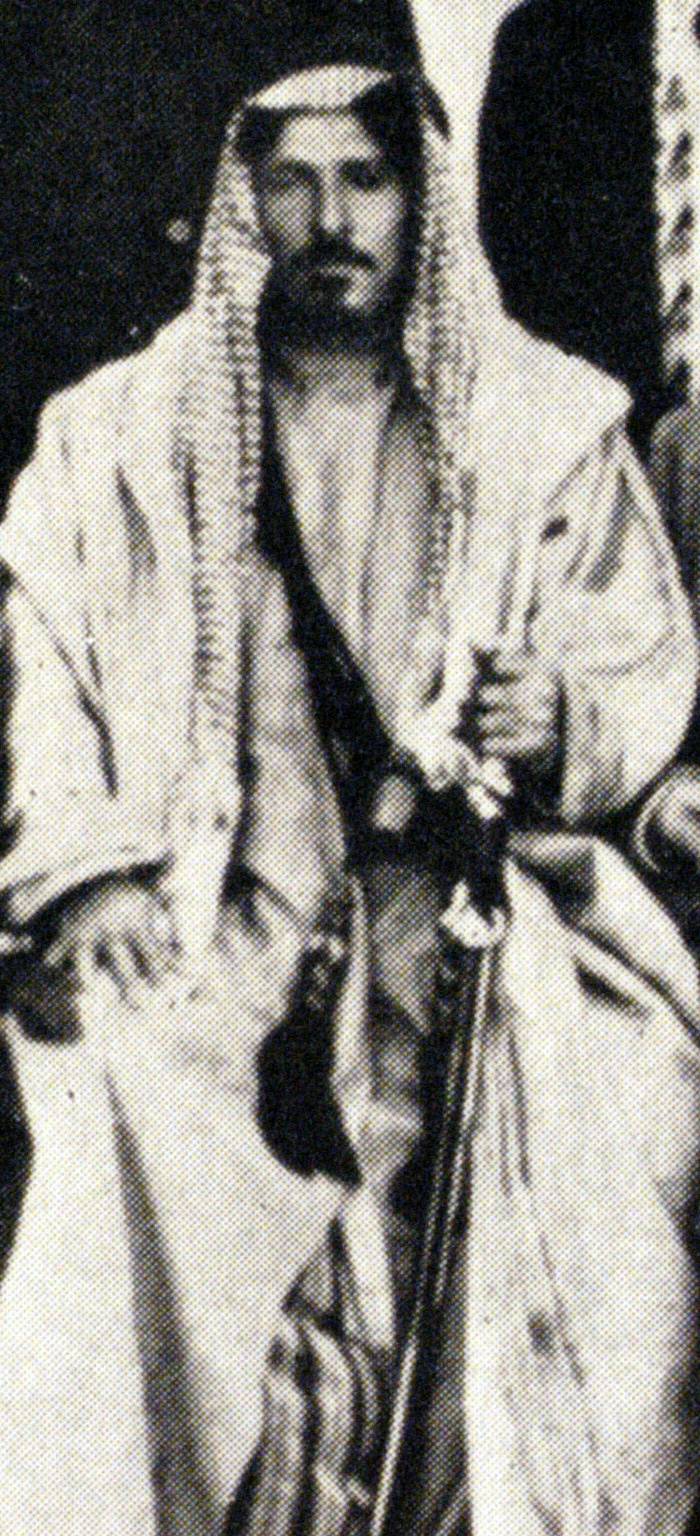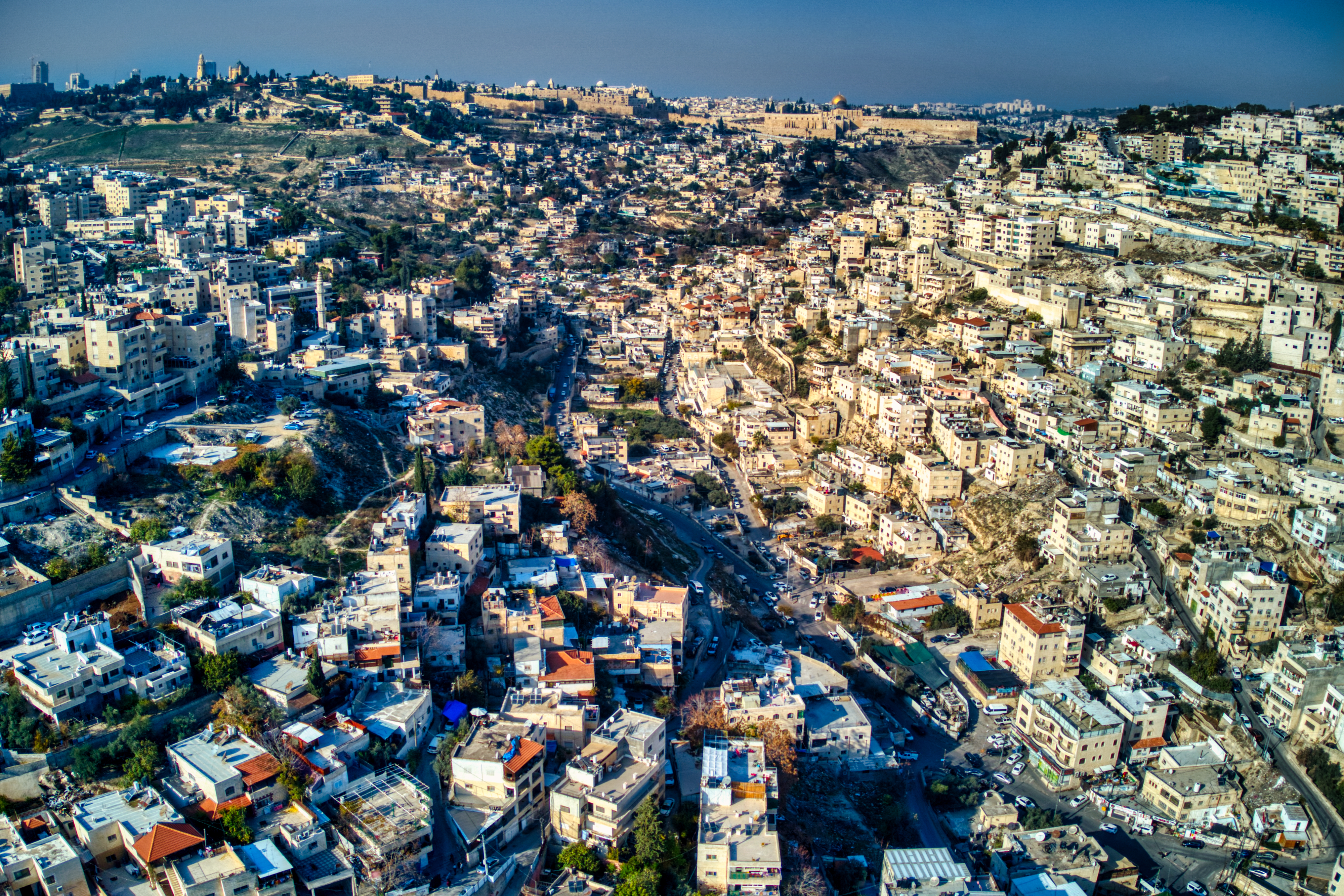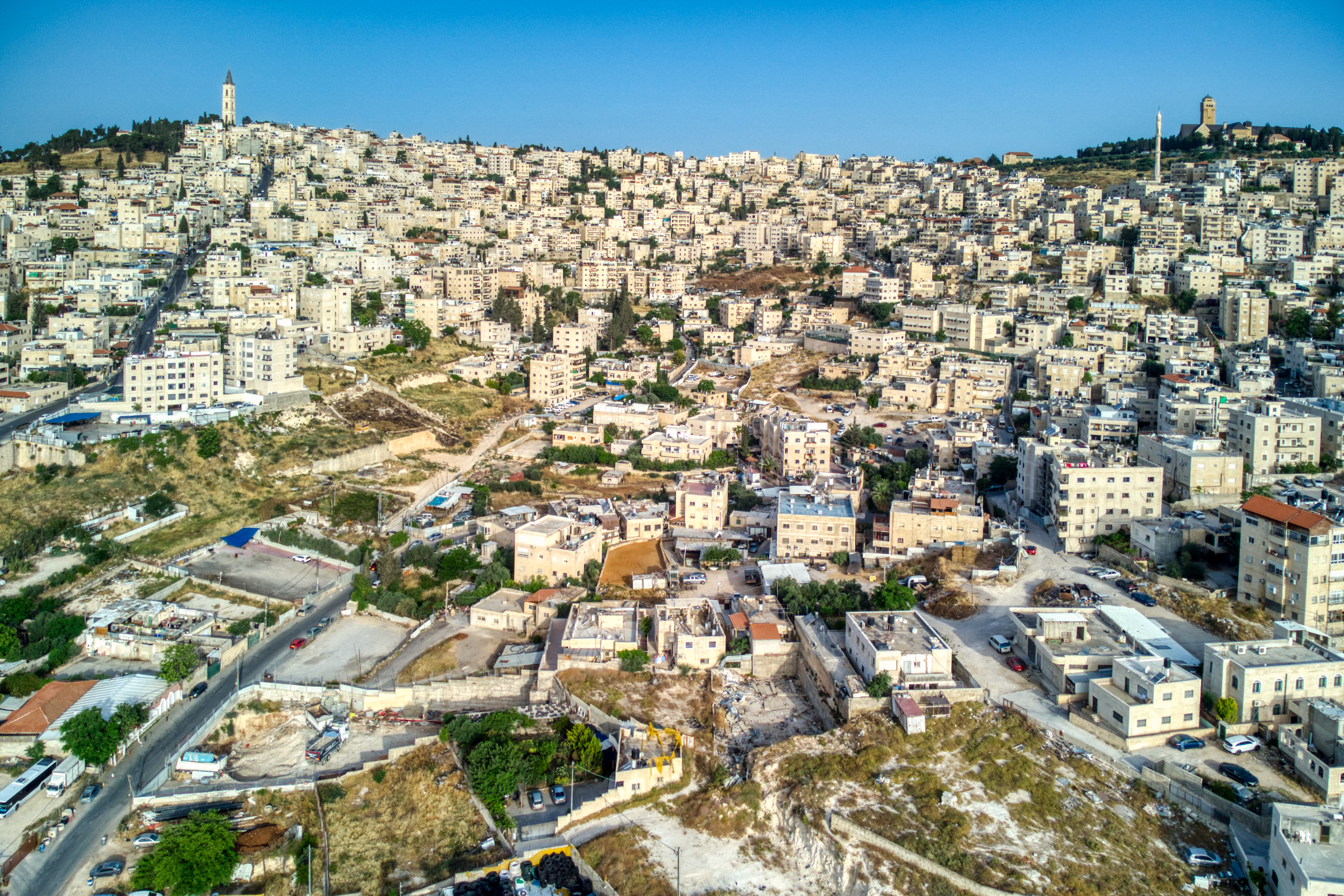|
Ta'amreh
Ta'amreh (in Arabic: التعامرة) is a large Bedouin tribe in Palestine. Today, most of the tribe's members live in the Palestinian Authority territories south and east of Bethlehem, and in the Kingdom of Jordan. Members of the tribe have established several permanent settlements in the Bethlehem area, known as the 'Arab et-Ta'amreh village cluster (Za'atara, Beit Ta'mir, Hindaza, Tuqu' with Khirbet al-Deir, Nuaman, Ubeidiya, Al-Masara and al-Asakra). History Nomadic Arab Origins, Lineage and Sub-tribes The Ta'amreh, also known as the Ta'amirah, is an Arab Tribe originating from the wilderness stretching from the Western Dead Sea Shores to Bethlehem and Tekoah. They were considered to be Bedouins (i.e. nomadic Arabs), and the tribe underwent through sedentarization alike several nomadic tribes. They were involved in the Qays–Yaman rivalry, and belonged to the Yemenite party. The Ta'amreh tribe descend from the Bani Harith tribe of Wadi Musa. Moreover, The Ta'amreh consis ... [...More Info...] [...Related Items...] OR: [Wikipedia] [Google] [Baidu] |
Beit Ta'mir
Beit Ta'mir () is a Palestinian village located six kilometers southeast of Bethlehem.The town is in the Bethlehem Governorate central West Bank. According to the Palestinian Central Bureau of Statistics, the village had a population of 1,596 in 2017. The village is named after the 'Arab al-Ta'mira Bedouin tribe of the Bethlehem area, and along with Za'atara, Hindaza, Tuqu', Khirbet al-Deir (today part of Tuqu'), Nuaman, Ubeidiya and al-Asakra forms the 'Arab al-Ta'mira village cluster. Location Beit Ta’mir is located south-east of Bethlehem. It is bordered by Za'atara to the east, Hindaza to the west and north, and Jannatah and Tuqu' to the south. History The village mosque, the ''Mosque of Omar'', has been tentatively dated to 636 CE. Ottoman era Beit Ta'mir was incorporated into the Ottoman Empire in 1517 with all of Palestine. In 1531, records from the Jerusalem Sharia Court mention an individual named 'Ali al-Ta'amari of the Ta'amreh tribe. This record places ... [...More Info...] [...Related Items...] OR: [Wikipedia] [Google] [Baidu] |
Nuaman
Nuaman or Khallet an Nu'man (, meaning "Grace"), also written Nu'man, al-Numan/an-Nu'man, is a small village located just north of Beit Sahour in the Bethlehem Governorate, Palestinian Governorate of Bethlehem. The Israeli government incorporated its territory within Positions on Jerusalem, Jerusalem after the Israeli occupation of the West Bank in the 1967 Six-Day War. The village is regarded as neither part of the West Bank, nor part of Jerusalem. A United Nations report has described the villagers as "living in limbo." In terms of local government it is treated together with the neighbouring village Al-Khas, to the west, as one unit. The village had a population of 112 in 2017. Settled by families from the at-Ta'mira Bedouin tribe, it is part of the 'Arab al-Ta'mira village cluster, along with Za'atara, Beit Ta'mir, Hindaza, Tuqu', Khirbet ad-Deir (today part of Tuqu'), Ubeidiya, West Bank, Ubeidiya and al-Asakra. Historical background Nuaman itself is a tiny hamlet, built on ... [...More Info...] [...Related Items...] OR: [Wikipedia] [Google] [Baidu] |
Peasants' Revolt In Palestine
The Peasants' Revolt was a rebellion against Egyptian conscription and taxation policies in Palestine between May and August 1834. While rebel ranks consisted mostly of the local peasantry, urban notables and Bedouin tribes also formed an integral part of the revolt. This was a collective reaction to Egypt's gradual elimination of the unofficial rights and privileges previously enjoyed by the various classes of society in the Levant under Ottoman rule.Rood, 2004, p139/ref> As part of Muhammad Ali's modernization policies, Ibrahim Pasha, the Egyptian governor of the Levant, issued conscription orders for a fifth of all Muslim males of fighting age. Encouraged by rural sheikh Qasim al-Ahmad, the urban notables of Nablus, Hebron and the Jerusalem-Jaffa area did not carry out Ibrahim Pasha's orders to conscript, disarm and tax the local peasantry. The religious notables of Safad followed suit. Qasim and other local leaders rallied their kinsmen and revolted against the authoriti ... [...More Info...] [...Related Items...] OR: [Wikipedia] [Google] [Baidu] |
Tuqu'
Teqoa (, also spelled Tuquʿ) is a Palestinian town in the Bethlehem Governorate, located southeast of Bethlehem in the land Samaria And Judah West Bank. The town is built adjacent to the biblical site of Tekoa (; also called Thecoe), now Khirbet Tuqu', from which it takes its name. Today's town includes three other localities: Khirbet ad-Deir, al-Halkoom, and Khirbet Teqoa. According to the Palestinian Central Bureau of Statistics (PCBS), Teqoa had a population of 8,767 in 2017. The town is a part of the 'Arab al-Ta'amira village cluster, along with Za'atara, Beit Ta'mir, Hindaza, Khirbet ad-Deir, Nuaman, Ubeidiya and al-Asakra. Tuqu has a municipal jurisdiction of over 191,262 dunams, but its built-up area consists of 590 dunams, as 98.5% of the village's land was classified as Area C, and 1.5% as Area B in the 1995 accords. Situated in the immediate vicinity is the modern Israeli settlement of Tekoa, established in 1975 as a military outpost. Israeli settlements in th ... [...More Info...] [...Related Items...] OR: [Wikipedia] [Google] [Baidu] |
Bani Sakher
The Beni Sakhar confederacy is one of the largest and most influential tribal confederacies in The Kingdoms of Jordan and Saudi Arabia. Its founder, Sakher bin Tha'labah al Tayy, a great-grandson of Jalhamah, likely lived in the 3rd century AD, making the tribe around 18 centuries old. The Bani Sakher began migrating to The Levant from the Hejaz as early as the 16th century and their influence continued growing until they became the most powerful tribe in northwestern Arabia around the mid 18th century. The Beni Sakher is made out of many clans, both through ancestry and alliances. These clans are primarily separated into three groups: the Al-Twaqa, headed by the princely Al-Fayez family; the Al-Ka'abneh, headed by the Khreisha family; and Al-Khdeir. History Origin The Bani Sakher was a tribe title that was given to more than one tribe, but the greatest and most famous of this tribes are the sons of Sakher bin Tha'labah bin Amro bin Alghouth bin Tayy, the progenitor of the Banu ... [...More Info...] [...Related Items...] OR: [Wikipedia] [Google] [Baidu] |
Abbadi (Bedouin)
Abbadi or Abbadids or Ibad (Arabic : بنو عباد) is an Arab Muslim dynasty and one of the biggest Bedouin tribes in Jordan. Abbadi is the second most common surname in Jordan. They are descended from "Qahtan" (Arabic : قحطانيون) Many researchers believe that Prophet Shuaib is from the same tribe. Despite the fact that they have the largest presence in Jordan (estimated at half a million people). However, due to early Islamic conquests, the Abbadi dynasty expanded extensively throughout numerous Arab countries, including Egypt, several North African countries, and eventually Spain or Andalusia. In which three generations of Abbadi khilafa ruled there and later established the Kingdom of Seville in Andalusia. Abbadi in Spain After the end of the Umayyad Caliphate rule in Andalusia in 1031 AD, it was the beginning of a new phase known in Andalusian history as "The Kings of the Taifas", In this difficult time people in Seville and the Andalusian West trusted Abu al- ... [...More Info...] [...Related Items...] OR: [Wikipedia] [Google] [Baidu] |
Beit Sahour
Beit Sahour or Beit Sahur (; Palestine grid 170/123) is a State of Palestine, Palestinian town east of Bethlehem, in the Bethlehem Governorate of the West Bank in the State of Palestine. The city is under the administration of the Palestinian National Authority. The population was of 13,281 in 2017, In the Village Statistics, 1945, 1945 statistics the population of Beit Sahour was 2,770; 370 Muslims and 2,400 Christians,Government of Palestine, Department of Statistics (1945), p24/ref> who owned 6,946 (rural) and 138 (urban) dunams of land, according to an official land and population survey. 1,031 dunams were plantations and irrigable land, 3,641 for cereals, while 100 dunams were built-up (urban) land. Jordanian annexation In the wake of the 1948 Arab–Israeli War and after the 1949 Armistice Agreements, Beit Sahur Jordanian annexation of the West Bank , was annexed by Jordan along with the rest of the West Bank. In 1961, the population of Beit Sahur was 5,316. Israeli occup ... [...More Info...] [...Related Items...] OR: [Wikipedia] [Google] [Baidu] |
Hutaym
The Hutaym (also Hutaim, Huteim) are a tribe of northwestern Arabia. Traditionally, they are considered a pariah group by the Arabs and their name has been used as a catch-all term covering other pariah groups as well, such as the ʿAwāzim of eastern Arabia and the Jibāliyya of the Sinai. Many groups labelled Hutaym call themselves Rashāyida .William C. Young (1997), "From Many, One: The Social Construction of the Rashāyida Tribe in Eastern Sudan", ''Northeast African Studies'', New Series 4(1): 71–108. Hutaym (plural Hitmān) is sometimes incorrectly spelled ''Ḥutaym'' or ''al-Hutaym''. The standard pronunciation in Peninsular Arabic is ''ihtēm''. It comes from the adjective ''ahtam'' and means "a man whose two front teeth are broken off at the root", that is, one who cannot trace his ancestry. A member of the tribe is called a Hutaymī. The main sections of the tribe are Āl Barrāk, Āl Qalādān, Āl Shumaylān, Maẓābira, Nawāmisa and Fuhayqāt. The head of Āl ... [...More Info...] [...Related Items...] OR: [Wikipedia] [Google] [Baidu] |
Silwan
Silwan or Siloam (; ; ) is a predominantly Palestinian district in East Jerusalem, on the southeastern outskirts of the current Old City of Jerusalem.Archaeology and the struggle for Jerusalem ''''. February 5, 2010 It is mentioned in the and the ; in the latter it is the location of Jesus' healing ... [...More Info...] [...Related Items...] OR: [Wikipedia] [Google] [Baidu] |
At-Tur, East Jerusalem
At-Tur (; ) is a neighborhood on the Mount of Olives approximately 1 km east of the Old City of Jerusalem. At-Tur is situated in East Jerusalem, occupied and later effectively annexed by Israel after the Six-Day War in 1967. History At-Tur is believed to be the location of the site of Bethphage (; ), a place mentioned in the New Testament. Archaeological excavations uncovered rock-cut installations, a quarry, columbarium, and rock-cut caves. Also found at the site are burial caves believed to date from the Second Temple period. The Chapel of the Ascension is located in At-Tur. Located on the Mount of Olives, the chapel is part of a larger complex consisting first of a Christian church and monastery, then an Islamic mosque. It is located on a site which the Christian faithful traditionally believe to be the earthly spot where Jesus ascended into Heaven forty days after his resurrection. Ottoman era In 1596, the village appeared as ''Tur Zayta'' in Ottoman tax registe ... [...More Info...] [...Related Items...] OR: [Wikipedia] [Google] [Baidu] |
Kidron Valley
The Kidron Valley ( classical transliteration, ''Cedron'', from , ''Naḥal Qidron'', literally Qidron River; also Qidron Valley) is a valley originating slightly northeast of the Old City of Jerusalem, which then separates the Temple Mount from the Mount of Olives, and ending at the Dead Sea. Beyond Jerusalem it continues in a general south-easterly direction through the Judean Desert in the West Bank, reaching the Dead Sea near the settlement of Ovnat, and descending along its course. In ancient Hebrew sources, as well as in Arabic, different segments of the valley bear different names. Arabic names include وادي الجوز, Wadi el-Joz, 'Valley of the Walnut', but possibly a shortening of "Valley of Josaphat", for the upper segment, near the Temple Mount; and Wadi en-Nar, 'Fire Valley', for the rest of it – with at least the segment at the ancient Mar Saba (' Saint Sabbas') monastery also known in the 19th century as Wadi er-Rahib, 'Monk's Valley'. In its upper par ... [...More Info...] [...Related Items...] OR: [Wikipedia] [Google] [Baidu] |
Issawiya
Al-Issawiya (, , also spelled ''Isawiya'' or ''Isawiyah'') is a Palestinian neighborhood in East Jerusalem. It is located on the eastern slopes of the Mount Scopus ridge. To the east and north, it is bordered by Road 1, which connects Jerusalem with the settlement of Ma’ale Adumim; immediately adjoining it to the north, west and southwest are the Hadassah Medical Center, the Hebrew University campus, the Jewish settlement of French Hill and the Ofarit military base; to the south, there is a planned park, the Mount Scopus slopes national park. In 1945, the village lands encompassed 10,417 dunams. Etymology Edward Henry Palmer in 1881 thought that the name meant "the place or sect of Jesus (called 'Isa in Arabic)."Palmer, 1881, p283/ref> History A burial cave, with pottery dating to the Early Roman period (first century CE), has been found at Issawiya. Two burial chambers were documented in 2003, one dating to the Roman period, the other to the Byzantine era (sixth–ei ... [...More Info...] [...Related Items...] OR: [Wikipedia] [Google] [Baidu] |




